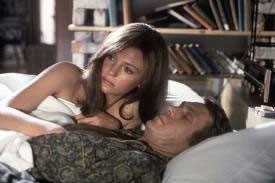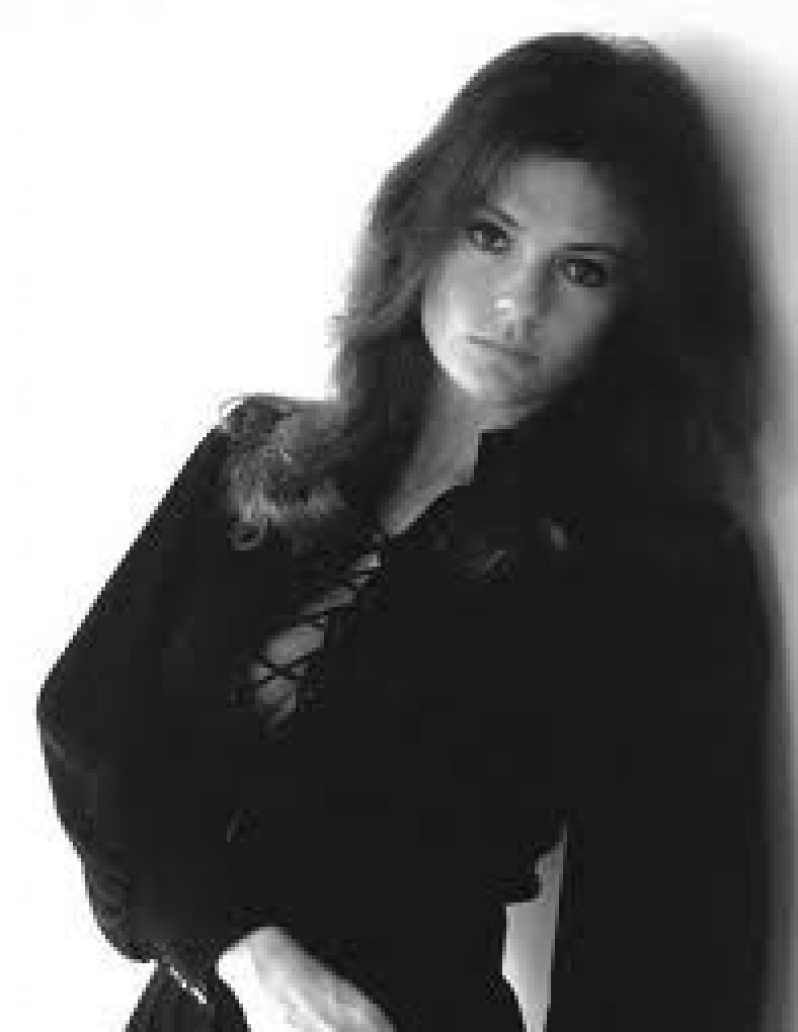TO SPEAK about Jackie Bisset as an attractive and riveting movie star is rooted in three values:
(1) Her ethnic/cultural makeup of Scottish, English, and French origin, also her apparent awareness of the distinct historical/cultural qualities of Scottish romanticism, especially in literature;
(2) the preciseness of her English diction; and
(3) the questioning objective and subjective liberation of French pragmatism and thought. All three of these qualities can be found in Bisset’s rendering of her roles, including a brilliant TV series as Josephine, Napoleon’s mistress.
Yet, at the same time, these qualities are so tightly integrated, like a second skin, and so fluently released, that what strikes us is a performance so characteristically subjective that only transparent perception will discover those three elements embedded in her presence on screen.
Photogenic gift/early films It all goes back to Bisset’s early love of being a photographer’s professional model. What do photos, especially of female subjects, really capture? Only hairstyles, poses, clothes, eyes, and beautiful bodies? Of course not! The camera x-rays to invisible qualities imaginatively suggested by the subject, like her creative shadow or aura. The model’s photos can also ask us what sort of literature does she absorb; what sort of music; what sort of films. Is she romantic; passionate? Does she have sex? With what sort of person/s? Does she enjoy it? And so on.
It all goes back to Bisset’s early love of being a photographer’s professional model. What do photos, especially of female subjects, really capture? Only hairstyles, poses, clothes, eyes, and beautiful bodies? Of course not! The camera x-rays to invisible qualities imaginatively suggested by the subject, like her creative shadow or aura. The model’s photos can also ask us what sort of literature does she absorb; what sort of music; what sort of films. Is she romantic; passionate? Does she have sex? With what sort of person/s? Does she enjoy it? And so on.
It is only after seeing a number of Bisset’s later films, say from 1968 up, that, if we have not as yet noticed her skill at projecting various discreet influential values, we are driven back in excitement to discovering those brief but wonderfully pleasant little roles in her first films, such as ‘THE KNACK’ (1965) , ‘CUL-DE-SAC’ (1966), ‘TWO FOR THE ROAD’, Audrey Hepburn and Albert Finney’s intelligent and wild romp across modern Europe, and ‘THE CAPETOWN AFFAIR’, with its mixture of romance and intrigue in tropical South Africa, both of 1967.
These and other early films proved Bisset’s gift for suggesting intelligence, sensitivity, and emotion, all wrapped up in her outward physical beauty in the camera’s frame. Hollywood in the 1960s noticed Bisset’s early European films, and it is one of her first films made there, ‘BULLITT’ of 1968, with Steve McQueen as the quiet, quick-thinking San Francisco detective Frank Bullitt, of few words, that Bisset as his live-in lover delivered one of her most practical, physical, almost silent renditions of romanticism’s original values. Her delivery involved stylish picturesqueness and imaginative suggestion, translated into the modern temperament of a new free-thinking, contemplative late 20th Century young generation.
Peter Yates We have to thank director Peter Yates for this subtle Hollywood masterpiece, ‘Bullitt’, a beautiful leading example of American New-Wave cinematic artistry which came to influence outstanding new directors like Michael Mann, Robert Towne, and Curtis Hanson.
We have to thank director Peter Yates for this subtle Hollywood masterpiece, ‘Bullitt’, a beautiful leading example of American New-Wave cinematic artistry which came to influence outstanding new directors like Michael Mann, Robert Towne, and Curtis Hanson.
And what does Bisset really do in her vital intermittent scenes? Almost nothing. That is, no flashy theatricality, no talkativeness or exaggerated gestures. Instead, her presence is a calm, confident, comforting antidote to McQueen’s (Bullitt) often violent job.
In her first scene, she jokes with him intellectually in her very short yellow mini dress at some sort of art-related job it seems, nibbles cereal alone at breakfast, watches and listens intensely to the jazz band when they dine at night with friends at a restaurant, and walks around their apartment only in a shirt.
But when she drives Bullitt one day in her yellow sports car to an assignment, and waits for him to emerge from a building, suddenly noticing a commotion of cops hurriedly running by her and entering the building, she, too, runs after them, and comes face-to-face with a half- naked dead girl sprawled on a lobby floor, strangled.
Confronted physically by Bullitt’s job for the first time, she runs away from him to the peace of a flower-laden San Francisco river bank, and it is here that Bisset’s voice erupts for the first time in brilliant, poignant, precise and passionate English against the violence in the world, in contrast to McQueen’s glib answers – like Randolph Scott’s sparse, minimal dialogue in Budd Boetticher’s special Westerns.
When Bisset, despairing of their life together, says to McQueen: “What will become of us in time, Frank?” he aptly sums up their Zen-like relationship with three words: “Time begins now.” The film’s final scene — of Bisset asleep nude in bed when detective Bullitt returns home and quietly opens their bedroom door after a terrible day — sums up Bisset’s beautiful cinematic knack for physical language as being.
Romantic imageBisset’s romantic image dominated cosmopolitan-type films, both European and American, from the 1970s onwards. As Julie, the beautiful but very self-conscious and nervous young actress French director Francois Truffaut brings to the set of a film about itself he is making , in ‘DAY FOR NIGHT’ of 1974, Bisset rivets us with her presence but little ‘acting’; yet powerful impressions of a sensitive person and actress emerge. This presence is filled with the truth of everyday life, and it drives viewers concerned with a satisfying self-image back to Bisset’s films.
Her 70s list include gems like ‘THE SPIRAL STAIRCASE’, ‘END OF THE GAME’, ‘DECEPTION’, while ‘ST. IVES’ and ‘THE DEEP’ ushered in highly pleasurable characterizations, both coy and erotic.
And if self-image is a theme, then how does the actress deal with aging, the dreaded twilight zone of their careers? In ‘UNDER THE VOLCANO’ of 1984, adapted from the avant-garde novel by one of Canada’s best 20th Century writers, Malcolm Lowry, Bisset, as the loose sensual but understanding wife of an a
lcoholic ambassador to early 20th Century Mexico, finds the correct progression in an amateur actress’s career.
In 1988, with the highly erotic, excitingly picturesque ‘WILD ORCHID’, focused on Brazil’s sensual interracial culture, Bisset combined rapid speech to her screen presence, like a way of creating her own excitement while acting.
The film seems not just a vehicle for objective storytelling, but the subjective evidence of this actress’s exciting involvement in her role. Indeed, one scene sums up ambiguously her own conscious creation of the romantic image, when she asks a young Brazilian boy staring at her: “You like what you see?” Any fan of great screen presences, such as hers, would probably reply: “Of course!”




.png)









